In-situ nanoplatform with synergistic neutrophil intervention and chemotherapy to prevent postoperative tumor recurrence and metastasis.
IF 10.5
1区 医学
Q1 CHEMISTRY, MULTIDISCIPLINARY
引用次数: 0
Abstract
In addition to residual tumor cells, surgery-induced inflammation significantly contributes to tumor recurrence and metastasis by recruiting polymorphonuclear neutrophils (PMNs) and promoting their involvement in tumor cell proliferation, invasion and immune evasion. Efficiently eliminating residual tumor cells while concurrently intervening in PMN function represents a promising approach for enhanced postoperative cancer treatment. Here, a chitosan/polyethylene oxide electrospun fibrous scaffold co-delivering celecoxib (CEL) and doxorubicin-loaded tumor cell-derived microparticles (DOX-MPs) is developed for postoperative in-situ treatment in breast cancer. This implant (CEL/DOX-MPs@CP) ensures prolonged drug retention and sustained release within the surgical tumor cavity. The released DOX-MPs effectively eliminate residual tumor cells, while the released CEL inhibits the function of inflammatory PMNs, suppressing their promotion of residual tumor cell proliferation, migration and invasion, as well as remodeling the tumor immune microenvironment. Importantly, the strategy is closely associated with interference in neutrophil extracellular trap (NET) released from inflammatory PMNs, leading to a substantial reduction in postoperative tumor recurrence and metastasis. Our results demonstrate that CEL/DOX-MPs@CP holds great promise as an implant to enhance the prognosis of breast cancer patients following surgery.具有中性粒细胞干预和化疗协同作用的原位纳米平台,可预防术后肿瘤复发和转移。
除了残留的肿瘤细胞外,手术诱发的炎症也会招募多形核中性粒细胞(PMNs),并促进它们参与肿瘤细胞的增殖、侵袭和免疫逃避,从而大大助长肿瘤的复发和转移。在有效消除残留肿瘤细胞的同时干预多形核中性粒细胞的功能,是加强术后癌症治疗的一种很有前景的方法。在此,我们开发了一种壳聚糖/聚环氧乙烷电纺纤维支架,可共同释放塞来昔布(CEL)和负载多柔比星的肿瘤细胞衍生微颗粒(DOX-MPs),用于乳腺癌术后原位治疗。这种植入物(CEL/DOX-MPs@CP)可确保药物在手术肿瘤腔内的长期保留和持续释放。释放的 DOX-MPs 能有效清除残留的肿瘤细胞,而释放的 CEL 能抑制炎性 PMN 的功能,抑制其促进残留肿瘤细胞的增殖、迁移和侵袭,并重塑肿瘤免疫微环境。重要的是,该策略与干扰炎性 PMN 释放的中性粒细胞胞外捕获物(NET)密切相关,从而大大减少了术后肿瘤的复发和转移。我们的研究结果表明,CEL/DOX-MPs@CP 作为一种植入物,在改善乳腺癌患者术后预后方面大有可为。
本文章由计算机程序翻译,如有差异,请以英文原文为准。
求助全文
约1分钟内获得全文
求助全文
来源期刊

Journal of Controlled Release
医学-化学综合
CiteScore
18.50
自引率
5.60%
发文量
700
审稿时长
39 days
期刊介绍:
The Journal of Controlled Release (JCR) proudly serves as the Official Journal of the Controlled Release Society and the Japan Society of Drug Delivery System.
Dedicated to the broad field of delivery science and technology, JCR publishes high-quality research articles covering drug delivery systems and all facets of formulations. This includes the physicochemical and biological properties of drugs, design and characterization of dosage forms, release mechanisms, in vivo testing, and formulation research and development across pharmaceutical, diagnostic, agricultural, environmental, cosmetic, and food industries.
Priority is given to manuscripts that contribute to the fundamental understanding of principles or demonstrate the advantages of novel technologies in terms of safety and efficacy over current clinical standards. JCR strives to be a leading platform for advancements in delivery science and technology.
文献相关原料
| 公司名称 | 产品信息 | 采购帮参考价格 |
|---|
 求助内容:
求助内容: 应助结果提醒方式:
应助结果提醒方式:


